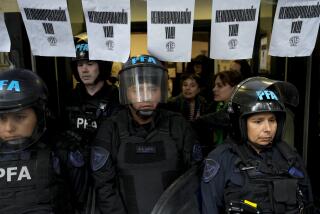Scant Domestic Output : 5 Auto Giants Battle for Argentine Market
- Share via
BUENOS AIRES — Five multinational manufacturers are caught up in bruising competition for a slice of Argentina’s already saturated auto market.
The more the market shrinks, the harder the giants battle for crumbs.
Aided by tariff walls, Argentina, along with Brazil and Mexico, is one of the three Latin American nations that produces automobile engines as well as bodies.
Only about 120,000 automobiles will be produced in Argentina for all of 1985, a negligible amount compared to the United States, where 7.7 million automobiles were produced in 1984.
The tiny market, however, has not stopped Ford, Renault, Peugeot, Fiat and Volkswagen from battling fiercely for a share, despite constant rumors of an impending Argentine industry shakeout.
“I don’t think this country can absorb more than two companies, three at the most,” said one auto executive.
The crowded competition has produced alliances of convenience. An Argentine company, Sevel, produces and markets both Peugeot and Fiat under license, an arrangement that allows it to offer both the highest-priced and lowest-priced passenger sedans.
General Motors, which folded up factory operations in Argentina in 1977, has returned to Argentina under the Sevel tent to produce its C-10 pickup truck under license.
A small, family-owned Argentine company called IES produces a car that looks like the old matchbox, corrugated-nose Citroen. In fact, say industry sources, the car is a Citroen whose patent has expired.
Volkswagen, which took over Chrysler facilities in 1980, produces a car much like the popular Argentine-made Dodge 1500, only it’s now called the Volkswagen 1500.
Work Shifts Reduced
To contend with the recession that swept Argentina and most of Latin America in the 1980s, the industry overall has reduced work shifts, producing at 50% capacity.
Industry experts predict that it will take several years before Argentina regains the production peak of 300,000 automobiles manufactured in 1980.
Badly hurt in the market collapse was the Ford Motor Co.’s Argentine subsidiary, which in the first five months of 1985 fell from first to third place.
Ford lost $78 million in Argentina last year. It is expected to reduce these losses substantially by the end of the year by trimmed labor costs and other expense curbs.
Ford’s red ink resulted not only from poor market conditions but because of heavy investments in a truck facility and body protection plant and a poor public reception of a new model, the Sierra subcompact.
“In 1984 Ford took its Taurus off the market and put out the Sierra, and that was a mistake,” said an executive of a rival producer. “Argentines don’t change their habits fast.”
Ford was rumored to be ready to pull up stakes in Argentina after it was battered last July by a 19-day sit-down strike in its manufacturing complex near Buenos Aires.
The company’s executives categorically denied the reports and adopted the advertising slogan: “Ford! It didn’t leave the country!”
“We intend to compete head-on,” said Ford Argentina President Robert P. Sparvero, who arrived from Detroit in April with orders to put the ailing company back into the black.
Ford’s two main competitors in Argentina, Renault and Sevel, both posted small profits in 1984, some $10 million for Sevel and $13 million for Renault.
Renault, now the top-selling auto maker in Argentina with 35% of the market, is expected to lose $15 million this year.
“Renault does not want to leave Argentina because we have our Latin American base here,” said Tibor Teleki, the firm’s director of general affairs.
“Our aim is to keep our technological advantage.”
Like Cottage Industries
Renault, Ford and Sevel produce over 80% of Argentina’s motor vehicles. Mercedes-Benz Argentina produces truck and bus engines and frames, some 2,247 for the first five months of 1985, while Saab-Scania Argentina manufactured 593 bus frames in the same period--volumes that seem more like cottage industries than mass manufacturing.
Aside from a limited market, auto makers in Argentina have had to contend with on-and-off government price controls, an erratic national economy, high taxes that compose 40% of the car costs, and 300 suppliers of auto parts that are sometimes unreliable.
Installment buying is virtually non-existent, a victim of the inflationary years of the late 1970s and early 1980s. Sevel offers payment over a six-month period, the maximum credit.
To add to this manufacturers’ nightmare, Argentines prefer small, rugged cars that offer high mileage and take plenty of punishment on dirt roads and pot-holed streets.
A new car has an average life span of 17 years, putting a premium on relible, proven models with good trade-in values and spare parts availability.
The Ford Falcon, which had a brief tenure in the United States, is still manufactured in Argentina after 22 years of restyling and remodeling. The Peugeot 504, introduced in 1974, is still going strong.
Yet there is no lack of new models. Ford, shrugging off reverses, introduced a Sierra station wagon this year. But, with such a thin market, shaky economy and crowded competition, the questions remains why more manufacturers don’t pack up and leave.
“The fact is, the companies made big investment in Argentina and don’t want to lose them,” said an industry spokesman.
“They made money before and think they can do it again.”
More to Read
Sign up for Essential California
The most important California stories and recommendations in your inbox every morning.
You may occasionally receive promotional content from the Los Angeles Times.













